We’d been on our first winter trek, in January this year, to a place called Har-Ki-Dun (Valley of God). We’d wanted to (especially) experience the snowfall and witness the draping of the ceremonial white veil over everything, all the more so after having seen three winters in Germany.
Such is the gravity of the mountains, that I am going to skip the background and other details and dive straight into the heart of the electro-chemical storm that’s still raging in the area of my head where these memories are stored.
Just like the previous trek entry (https://gabbartrip.wordpress.com/2014/03/16/a-magical-trek-to-roopkund/), this will be a fairly long entry, simply because nature and the mountains have so much to offer, that putting it down in few words is tough, and unjust.
We changed several modes of transport and eventually reached Sankri which is the trailhead. The layers of fatigue were washed off when we saw the sparkling green, pristine waters of the Tons river flowing alongside tall pines which in turn carpeted tall hills. In our encyclopedic ignorance, we had thought that we would not be able to see such clear, green waters in India once we had returned back from Europe. But, of course we could. This magnificent collage of colours now seems to be present and stretching from the Julian Alps all the way to the Himalayas and who knows elsewhere. In such a big world, the amount, similarity and the diversity of beauty is indeed astonishing.

Green watered cousin from Slovenia:
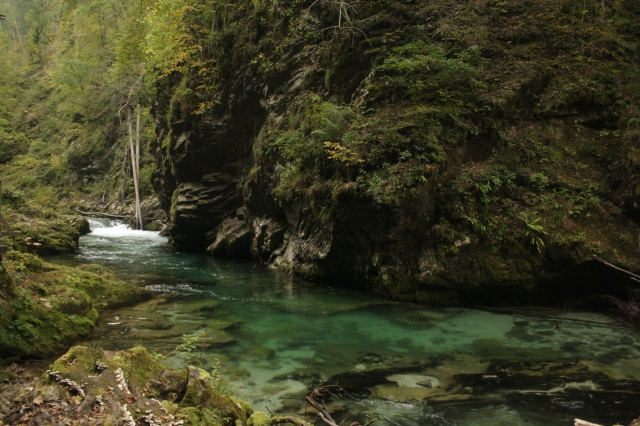
The trees and mountains filtered the winter sun’s inclined rays on an anyway tilted face of the earth, and added an enriching layer of long shadows, silhouettes and gentle back-lit shades. We had some chirpy company in the car –Meenal and Anil (meaning Air) with whom the conversation remained a jolly and breezy affair. Her comment (technically an excuse!) of having to sit in the front seat since not only was she alert and awake, but also because she was a good driver and would assist the driver in pressing the (imaginary) brakes at her side, was quite infectious. I see the passenger foot-well as having brakes as well now!
The locals looked different by now – their attire, their features, their language and mannerisms, the type of songs that were played in cars and restaurants . Drivers teased each other and wedding songs played out in the car, which itself was ‘decked’ out in colorful carpets, stickers and a row of glass bangles jangling between the sun visors in the front row! Due to the inclines, a few buildings had vehicle parking on the terrace (which was closer in level to the sloping roads in places) and post lunch, going to the parking lot needed a change in habit. All this ‘foreign’ stuff right within India – just shows that once you increase your sensitivity, the observations just increase many fold. (“The real voyage of discovery consists not in seeking new landscapes, but in having new eyes” – Marcel Proust)
Reaching the base ‘camp’, the energy of the batch which had just returned was noticeably high. Our group was starting very slowly in that regards, a formal round of introduction not doing much in terms of team building. It would take more than a day’s climbing, a bit of perspective from our trek leader and a round of informal ‘’share-your-most-memorable-moment-in-life” discussion which helped. A couple of people were more instrumental in pushing up the group’s energy and this rubbed on eventually to a point where it felt like a team by the end of the trek.
The first day was 11 km of up and down through a beautiful valley. The mountains were brown and snowless, turning into deep orange in the setting sun’s light. The trail ran alongside the Supin river (the Rupin and Supin rivers join into the Bhaghirathi), and the constant rush of water was impressive to see. Crossing old wooden bridges, and also rafts of planks acting as bridges, we occasionally climbed higher from where the river looked a completely different shade. The trail forked several times, but the trick was to follow mule excreta along the way. Mules are the lifeline here; not only assisting the villagers in their daily transportation but also assisting the trekkers in carrying loads during the trekking season.

Young kids waved wildly and continuously as they saw us walk by lower down in the valley. We waved back, and shared a moment of innocent playfulness with them as we made actions and gestures which they copied, only for us to change them, or change the pace, and wait for them to respond. Smile, rinse and repeat! As always in villages, kids seem to be so full of energy and innocence and able to take joy out of seemingly nothing. This is something we would experience again on the last day of the trek.

Patches of ice on the trail made walking tricky. Parts of the trail looked like they didn’t receive much sunlight (thanks to the mountain slopes and trees on both sides) and it seemed that these patches would melt only when the temperature rose later on in the year.

We had paused for lunch when we had reached a clearing, soaking in the sunlight and the views for a moment before moving onward.

We were a mixed group – young and old (early 20’s to mid-50’s), rookies and experienced (multiple high altitude treks and expeditions), people with different priorities (some who wanted to trek more than talk or photograph more and so on) and it was inevitable that the group split into sub groups. If anything, this led to some photographs of the trail with people on it.

Reaching Osla, an old village, considered one of the older ones in India at about 2000 years old, we took a small break and walked through the small settlement of houses. It was a rich culture locked away in the folds of the mountain, preserved by the isolation and harsh weather of the region.
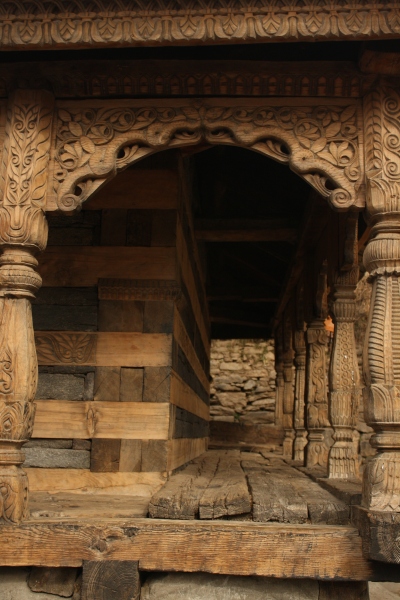
We are unaware of its history, some have said it is a Shiva temple, some said it is a Duryodhan temple. Need to read more about it.


Musical instruments stored in a house balcony. We were told that each village has a festival every month which is celebrated with music and a big feast

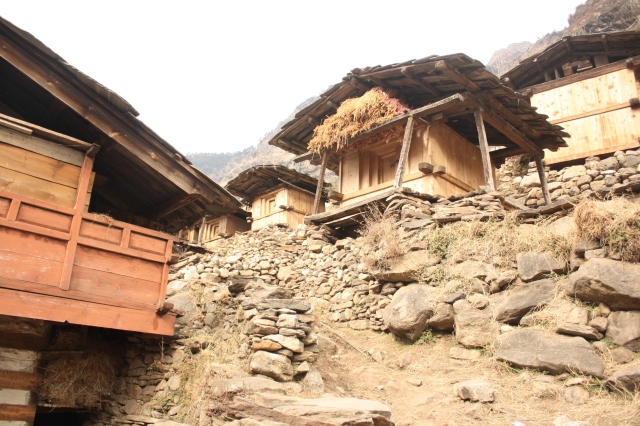
Beautiful wooden houses, storage for straw / grass was very well designed
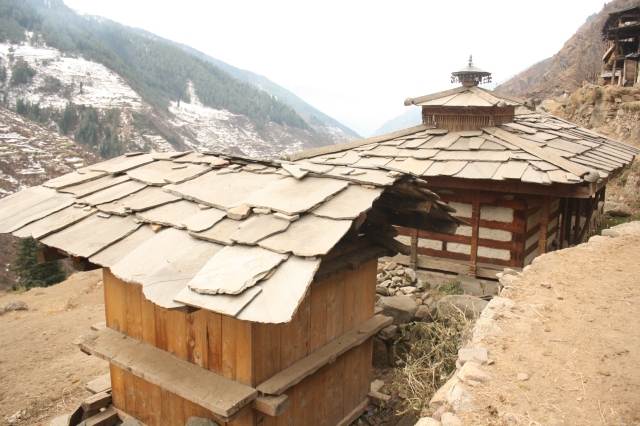
Stone roofs
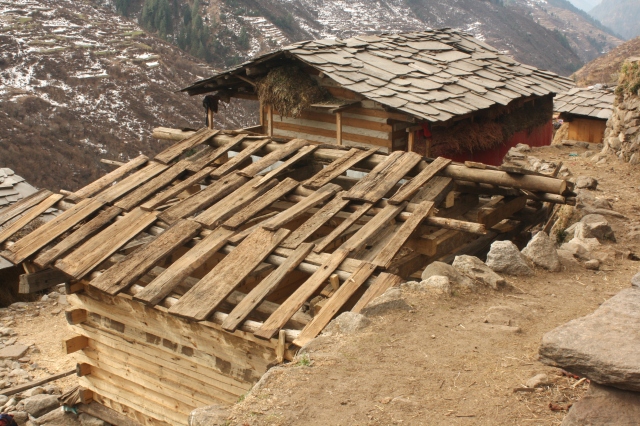
Wooden frame for the roof – simple and effective

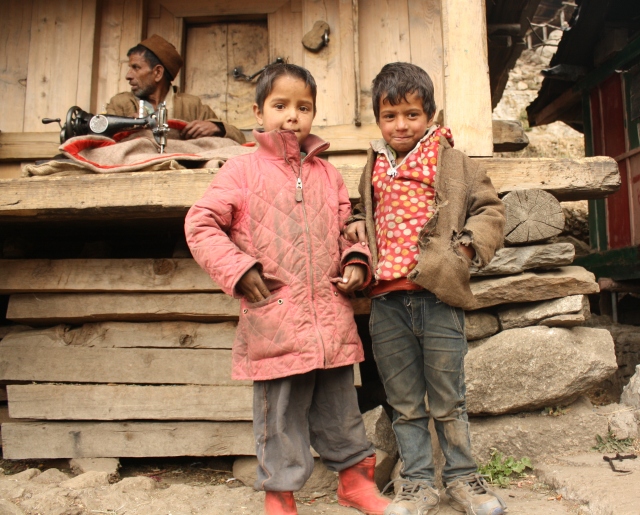
Probably an Uttarakhandi coat being stitched.
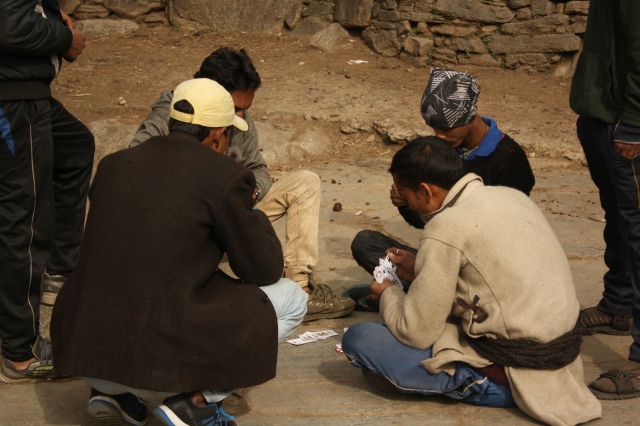
Saw a lot of men playing cards
We saw women washing clothes in a big wooden bowl inside which they climbed and stamped the clothes clean. At the end of the trek, we gave our medicines to Max who was collecting them for the village. We also saw toddlers learning how to walk directly on the rolling terrain, something which was quite scary!
Further on, we saw a frozen waterfall across the valley.

We reached the campsite, legs and resolve a little shaky after the first day’s climb, but the fatigue was nothing that a few moments of rest and some food wouldn’t cure. The importance of staying hydrated was reiterated and by evening all was well. Garlic soup helps in acclimatization and was a healthy welcome choice. We were told to drink atleast 4-5 liters of fluids now.
The wish to see a lot of snow and a deep dark starry night wasn’t really being fulfilled though. There was a lull in snowfall, and the skies were either cloudy at night or were polluted through smoke from the fires lit by villagers to clear land for sowing mainly grass, and by the solar lighting in the villages. However, it was much clearer than the city ‘air’ that we live in and we still saw some spectacular sunsets, moon-rises and shooting stars 🙂 Not being able to see what we’d imagined we would be able to see on cold, dark nights at high altitude was a fair disappointment, but it is easier to get rid of such disappointments in such regions. The scale of everything (the peaks, skies, clouds, forests, meadows, etc) offered much variety, and the almost knife-straight stream trimmed wayward thoughts quickly.
Leaving the Kalkatiyadhar camp the next day, we started climbing. It would be a shorter climb, however it would be the day with the first view of the peaks! Looking back, we caught a glimpse of the beautiful campsite


Greeted by stunning views. The stretch of white is known as Devasuthaj, which reflected the moonlight in a very ethereal fashion. Just loved it.


“The reason why most places of power and grace have always been on mountain tops is because by the time you reach there whatever ideas you have about yourself shall fall apart.” – Sadhguru, from the book ‘Ultimate Outlaw’.
What Sadhguru has said above makes so much sense. Once broken, if one is conscious, you will be careful and more observant about what kind of image you are building about yourself. Effectively you are getting a chance to reform (re-form) yourself since it is only after you have dismantled certain ideas that you can realign them better. This is what the trail does to you – your notions of limits, strength, control etc. are all dissolved away and replaced with a healthy dose of humility mixed in.

Our guide and sweeper, Max and Monu, heroes who helped out everyone throughout the trek. Proper Kudos to them.
The trail was difficult for the mules as well – with steep drops on one side, and with us taking up space from their paths while we hugged the mountain and forced them to creep towards the edge negotiating us…Felt a little sorry for them..

Nearing the final campsite, the switchbacks and the views got even more stunning.

Light and shadow added even more depth and contrast to the landscape. The colours were stunning – dark canopies, bright tree barks, pale boulders with bright tufts of grass, and of course shiny patches of snow..
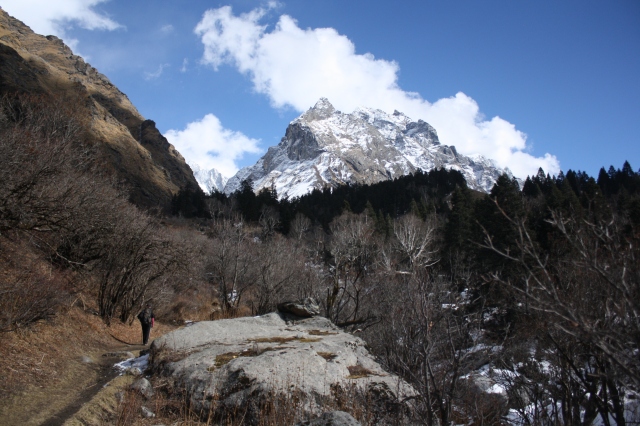
The trail criss-crossed paths with semi frozen streams. At a couple of places downstream, we had seen flour mills powered by these waters busily grinding the local cereal.

while the grass seemed to be on fire..

Dogs are much respected in Uttarakhand and there is also a story from Mahabharata associated with them. Next to Har Ki Dun peak stands the (huge) Swargarohini massif. It is said that Yudhishthir chose to remain true to the dog till the end; the dog had been faithful to him and eventually led him to Swarga while the others perished on the way. Hence the peak is named Swargarohini, i,e, Swarga (Heaven) + Aarohan (to ascend) The dog is considered to have been an avatar of Indra.
Later on, while walking near the campsite, we ”spotted” a ”dog” in the stream. Are you able to as well?

Stunning campsite – flanked by mountains, ego dissolves. Hata peak and (part of) Har-Ki-Dun peak visible here

Colors erupting as the sun sank lower.

Colors erupting and saturating , some colors brighten up the day months, miles and moods away..

Sunset by the river


As the night wore itself and us out, a frozen combination of clogged nasal passages, bursting bladders and numb toes and fingers stepped out into the morning, to the cries of ”Chalo guys!! Chaaaaai!!”. Run! 🙂
Is the sun already up? Yes. But it is not visible. It has risen behind the mountain in the east, and the first sunrays are instead visible on Hata peak in the west! Every day that we saw the possibility of a sunny day, our hopes soared, and the mind got ready, checking knees, ankles, back, shoulders, etc. for suppleness. We traced the rising sun and the sunlight, as it trickled in, slowly, gathering intensity and pouring into the valley, filling it from top to bottom. The ‘simplest’ of the natural phenomena seem to have the most magical effects. Maybe we would appreciate it a bit more in the cities too, if we were not so hot and bothered about things already. Sigh.
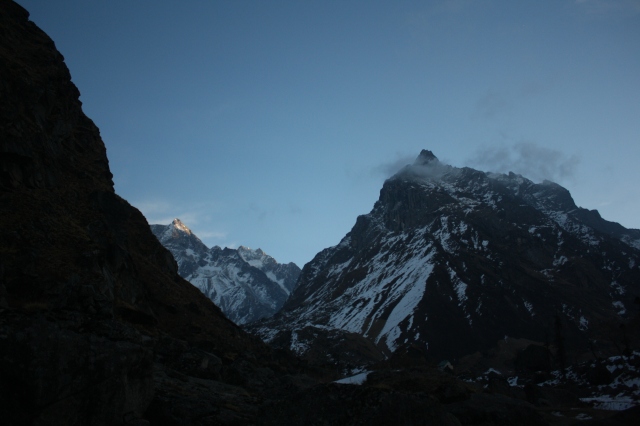
Sun rays on Kedarkantha

Camping here was a privilege. The views were stunning, the weather harsh. Water in our bottles froze inside the tent if you had forgotten to put it inside the woolen liner where body heat would keep it ‘warm’. We had a buffer day here, and a few hours were spent memorably peeping out of the tent, away from the wind.

We had a day off which we spent well wandering off near the campsite towards Jaundhar glacier and the V-A-S-T snowfields nearby.
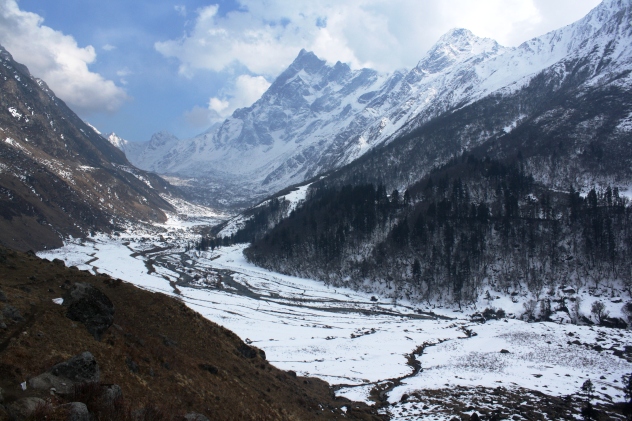
The scale of the place was spectacular. Check out the tiny specks walking in the centre of the photograph below.
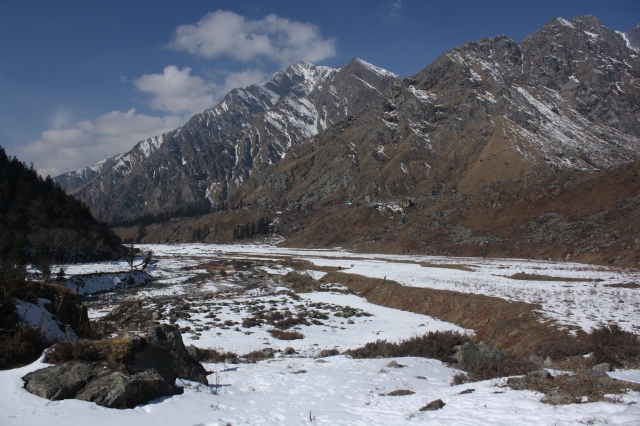
Back at our camp for the final night, we packed up knowing we would be leaving the next day. Sooner than I liked, it was time to turn back downwards. The trek was almost over. Another 2 days of walking and it would be done. Drink, drink, drink – don’t forget to drink – Again, after a rest day at the Har Ki Dun campsite (rest meant walking slower and with just a day-pack) the Partial O2 and heart rate readings had improved. It constantly amazes me how the body adapts.
In our dinner tent, there was a special moment when Max played a song on his phone which he kept inside a steel jug. Check out the Kabir song here –> https://www.youtube.com/watch?v=rQBn90M9ixo. Thank you Max! 🙂
The next morning, we woke up with one eye on the sky especially since there had been a few snowflakes over the past couple of days. This was the last batch before the trail closed for winter, and all the wonderful support staff would be packing up each camp along the way as we all went back. Our guides and trek leader were concerned about impending heavy snowfall – “It hasn’t snowed since many days, and if it starts now, it won’t stop for several days. We need to move.” Breakfast done, sleeping bags rolled, bodies stretched, water filled, snacks packed, backpack straps adjusted, we start off.
After crossing the village on the way down, we saw a man climbing up with a cloth sling across his chest. We had stopped for a pause and we got an inkling it was a baby, to which he confirmed, saying it was indeed a 3 day old newborn baby. I asked if his mother was ok, and his reply was ‘she is just a few minutes behind, on her way’. To imagine a mother climbing up such steep slopes within three days of delivering a child – that is strength. All our ideas of how romantic life is on the mountains were washed out. We city people seem to be patting our backs for carrying our own back packs…
The views meanwhile continued to be beautiful.
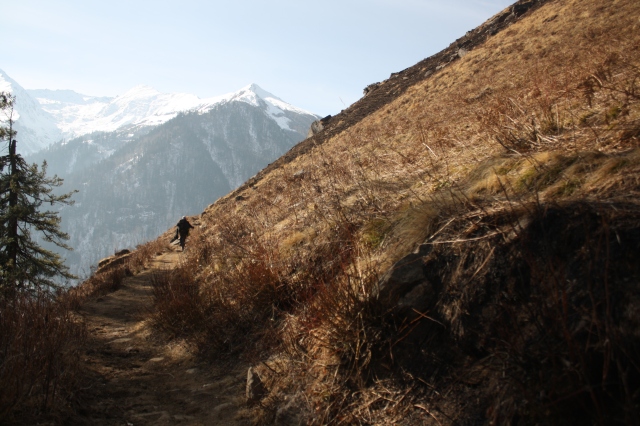
Overall, for us, the trek was challenging, but doable. We were much more disciplined and better prepared than the last time around. Lots of fluid intake, eating proper food (daal / chawal, and not junk food), listening to the body and mind, stretching at the start and end of the day, breathing deeply, walking around the campsite once the day’s trek had ended helped us acclimatize better.
Edit: I am reminded of these psychotropic words by Albert Camus when I think about the experience now: “In the midst of winter, I found there was, within me, an invincible summer.”
What pained me a lot was seeing the rubbish litter of plastic wrappers, defacing this majestic work of creation like ugly graffiti – “Man loves plastic” or “We came, we munched, we littered”. So disrepectful and harmful. Awareness and concern / compassion towards something beyond ourselves is what will slow down and hopefully kill this plastic menace. Lessons we learn in the mountains, in nature – consume less, live sensibly, plan before you do something, show some respect, be punctual and disciplined – these need to be brought back to our cities. Life without a mobile phone is possible, an orange peel may work very well as a scrub and sunscreen, listening to your body and respecting it will take you places, how you talk to the people in the mountains maybe can be brought back ‘downstairs’. We had been given Eco-Bags by Indiahikes (http://indiahikes.in/green-trails/), and we tried to pick up as much litter as we could. The quest and resolve to consume ‘increasingly lesser’ packaged items (food, lifestyle, etc.) got strengthened there (take just 1 biscuit packet between the two of us, instead of the one per head allocated) and the same quest continues everyday here as well. I hope I can lead a lifestyle with minimal long lasting impact, and hope that several small steps will quickly help me cover a lot of ground in that direction. What motivates me to consume lesser is the timeline showing how many years things take to decompose (bottom of the page in the link above). It is quicker, and better, to let a poor habit decompose instead 🙂
Again, this trek would have been very different and difficult without Monu and Naaru (assistant trek leaders / sweepers), Naina-the cook, Max, our trek leader and the other staff who were so capable and jovial while doubling up and performing multiple roles seemingly effortlessly. Also thanks to the guys off the slopes and in the offices who make the entire process easy and efficient. May you all be happy and trek safely!
Edit: Here’s something I would wish for you and for everyone who might want to experience this : “May your trails be crooked, winding, lonesome, dangerous, leading to the most amazing view. May your mountains rise into and above the clouds. May your rivers flow without end, meandering through pastoral valleys tinkling with bells, past temples and castles and poets towers into a dark primeval forest where tigers belch and monkeys howl, through miasmal and mysterious swamps and down into a desert of red rock, blue mesas, domes and pinnacles and grottos of endless stone, and down again into a deep vast ancient unknown chasm where bars of sunlight blaze on profiled cliffs, where deer walk across the white sand beaches, where storms come and go as lightning clangs upon the high crags, where something strange and more beautiful and more full of wonder than your deepest dreams waits for you — beyond that next turning of the canyon walls.” – Edward Abbey
Some of the trek members we had were very inspiring – elderly people in their mid-50’s, who climbed, spoke and understood things so well that they left a good mark in the memory. I am happy that most of us are still in touch, and I would like to meet all the members of the trek again.
It is difficult to forget an immersion such as this one in nature, the simple reason being that a part of me is still there on the trail, trying to stay warm, soaking in the views, breathing in the clean air and feeling privileged in being able to be having such experiences.
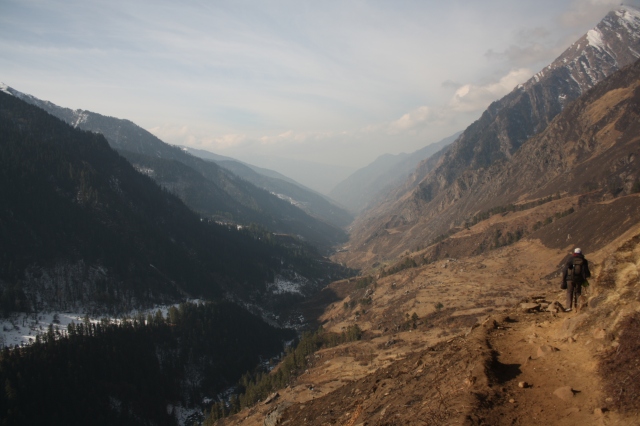
~~~
